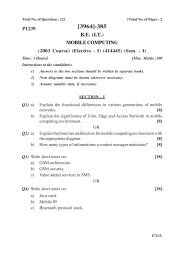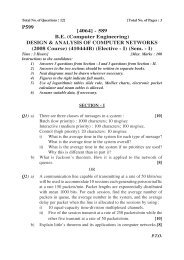Cloud Computing and SOA Convergence in Your Enterprise: A Step ...
Cloud Computing and SOA Convergence in Your Enterprise: A Step ...
Cloud Computing and SOA Convergence in Your Enterprise: A Step ...
You also want an ePaper? Increase the reach of your titles
YUMPU automatically turns print PDFs into web optimized ePapers that Google loves.
122 Chapter 6 Work<strong>in</strong>g from <strong>Your</strong> Services to the <strong>Cloud</strong>s<br />
we need to keep track of semantics, validation constra<strong>in</strong>ts, formats, <strong>and</strong> so<br />
on, around data, we have the same needs <strong>in</strong> terms of how we manage, underst<strong>and</strong>,<br />
<strong>and</strong> track services.<br />
Behavior (the core value of services) is a notion very different from <strong>in</strong>formation.<br />
Behavior is much more “liv<strong>in</strong>g <strong>and</strong> breath<strong>in</strong>g” than data <strong>and</strong> provides<br />
not only <strong>in</strong>formation but dynamic <strong>and</strong> complex services around that<br />
data. This is why we leverage services as well as data for <strong>in</strong>tegration. There is,<br />
however, no st<strong>and</strong>ard approach to describ<strong>in</strong>g services at a higher level. With<br />
the public nature of services these days, as well as the rate of service replication<br />
<strong>and</strong> abstraction, this should be on the top of our to-do list.<br />
With the advent of Web Services, we now have thous<strong>and</strong>s, sometimes<br />
tens of thous<strong>and</strong>s, of services under our management (private services). To<br />
make matters even more complex, we also have to consider services that are<br />
out of our direct control: those shared from cloud comput<strong>in</strong>g platforms<br />
(public services). While we do have some basic <strong>in</strong>formation about them, as<br />
def<strong>in</strong>ed by st<strong>and</strong>ards such as Web Services Description Language, we really<br />
need a more complete set of <strong>in</strong>formation surround<strong>in</strong>g the services. This <strong>in</strong>formation<br />
should <strong>in</strong>clude the purpose, <strong>in</strong>terfaces, parameters, rules, logic,<br />
owner, semantics, <strong>in</strong>cluded services, <strong>and</strong> other important data. We can def<strong>in</strong>e<br />
these attributes with<strong>in</strong> the services directory, which we def<strong>in</strong>e next.<br />
Creat<strong>in</strong>g the Services Directory<br />
Us<strong>in</strong>g the previously def<strong>in</strong>ed concept of metaservices, let’s now explore how<br />
to document those services for the purposes of our <strong>SOA</strong> us<strong>in</strong>g cloud comput<strong>in</strong>g<br />
architecture. Earlier <strong>in</strong> this chapter, we def<strong>in</strong>ed the need to create a list<br />
of c<strong>and</strong>idate services as well as to create a f<strong>in</strong>al services model, us<strong>in</strong>g our case<br />
study as an example. Now we look at the concept of a services directory,<br />
which is basically a directory of services that you discover, identify, <strong>and</strong> def<strong>in</strong>e<br />
as you ga<strong>in</strong> a service-level underst<strong>and</strong><strong>in</strong>g of your problem doma<strong>in</strong>, <strong>and</strong><br />
look to replatform some of these services for cloud comput<strong>in</strong>g. We know by<br />
now that we need the follow<strong>in</strong>g <strong>in</strong> our services directory:<br />
Semantics<br />
Purpose<br />
Authentication<br />
Dependencies<br />
Service levels












